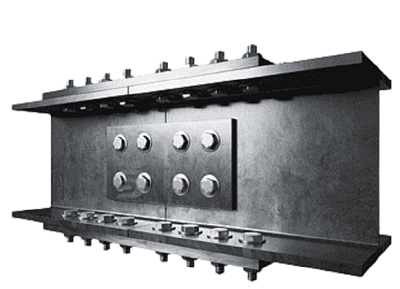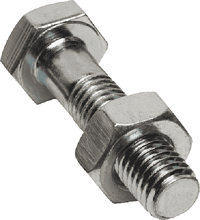Advantages and Disadvantages of Bolted ConnectionDue to the increased flexibility of assembly and disassembly of sub-systems for inspection, replacement, and routine maintenance, bolted connections are widely employed in practically every mechanical and structural system. The weakest link in a design is frequently a bolted connection; in many circumstances, the fastener connection can determine the dependability and safety of an entire system. A straightforward bolted connection may consist of a threaded fastener (bolt, screw, or stud), a nut or tapped hole, and the components that would be held together by preloading the bolt; typically, this would be done by tightening the head or the nut. The transfer of varied service loads through the clamped connection would be possible with the bolt preloaded in a bolted connection: either directly or by creating more friction at the joint's contact surfaces. One of the typical control mechanisms is used to tighten a threaded fastener to a particular preload (tension). 
Any steel structural system comprises various joined or attached components, often at the member ends, including beams, columns, and tension members. A steel structure's many members may be constructed from various materials, including plates, angles, I-beams, and channels. To join these many parts together, fasteners must be used effectively so they may function as a single composite unit. Steel framework connections enable the transfer of forces up to the foundation level and facilitate the passage of forces and moments from one part to another. The primary objective of connection design is to create a junction that is secure, affordable, and straightforward (so that it can be manufactured and assembled at the site without any difficulty). Additionally, it's crucial to standardize connections inside a structure and to detail it in a way that gives adequate clearance and adjustability to meet any fit issues, resists corrosion, is simple to maintain and has a good look. Every steel design aims to guarantee that the components are properly attached. When creating functional joints, connection designers are guided by three criteria: Economic, Safe, and Effective. When this happens, the manufacture of metal bolts is quite useful. Dealing with clearances has become simpler due to the standardization of these connections. It has become simpler for industrial users to modify its size or grip as necessary. Advantages of Bolted Connections1. Bolted Joints are Simple to Operate Due to its simplicity of application, the bolted connection is a desirable technique. It needs a basic torque tool to function and combines a screw or stud with a threaded counterpart like a nut or tapped hole. This sets it apart from other technologies: Bonding is a method that depends on the operator's skill to assess its quality and appropriateness. This assembly involves press tools, which adds complexity to the operation. Welding necessitates a qualified welder and sophisticated equipment, and failure may be noticed. 2. Bolted Joints Can Move The same tools used to build it may be used to remove and reuse a bolted joint, which is not a permanent assembly. This is particularly useful for maintenance, quick inspections, or part replacement. The ability to properly separate, sort, and recycle pieces composed of various materials makes it helpful even when a product is nearing the end of its useful life. 3. There are Several Sizes and Types of Bolts Depending on the application's requirements, various sizes and materials are available for bolts. Steel is a material that is frequently used for them, providing strong mechanical properties that are typically more than the capacity of the combined pieces. 4. Various Materials can be Clamped Together with Bolts Bolts can attach components of materials other than metal, such as composites and polymers. Making this assembly compatible doesn't involve any unique setup or design. 5. Bolts can Hold Thick Pieces in Place The thickness of the combined pieces might be as thick as necessary to satisfy the manufacturer's requirements. This often denotes routine, affordable machining techniques that are well-known. Large tolerances can be used to generate the thickness and hole size. 6. Bolts may Function in a Variety of Temperature Ranges Bolts made of normalized steel can withstand temperatures between -50°C and 200°C, whereas stainless steel bolts can withstand temperatures between -160°C and 500°C. To get the connection to the desired level of performance, special designs employing materials able to withstand high temperatures and alloys able to work in an acidic environment are required. 7. Strength Will be Higher The nuts are kept from coming undone since the loads that cause fatigue will be within the proof load, and the joint's fatigue strength will be higher and better than that of welded and riveted joints. Additionally, because of the frictional load transmission, there is no stress accumulation in the perforations. The connections may be made with fewer people than with riveted joints. 8. Simple Fabrication There is no need to be concerned that extra bolts will be required. Technicians can quickly duplicate the bolt you already have in your possession and produce additional of it for your needs because they are simple to construct. 9. Making Use of Basic Tools One of the most significant advantages of employing bolts as connections for steel buildings may be this. It doesn't call for sophisticated equipment or knowledge that only a select few possess. 10. Bolts Can be Installed Without Following a Specific Process This implies that it may be used right away after installation. It works without a specific procedure or piece of machinery. Disadvantages of Bolted ConnectionEngineers must decide which material or tool is best to do specific tasks throughout any project's planning and design phase. Normally, the overall design of a structure determines the sorts of joints that will be utilized. Still, the design engineer must also consider cost, installation time, and overall performance. There are several drawbacks to bolted connections depending on these extra circumstances, such as, 1. Types of Bolted Connection Failure Bolted connections may fail to owe to a problem with the connection itself or a problem with the elements that link it. By following the edge spacing requirements described in IS 800: 2007, several of these problems, such as the plate's shear failure, the plate's splitting failure, and the plate's bearing failure, can be avoided. They are, therefore, unimportant, but the others merit serious consideration. Any one of the six below-listed failure modes for the bolted connection can occur.
2. Precision of Joint The joint's tightness determines how accurate a bolted joint is depending on the friction between the nut and bolt. 3. Axial Tensile Strength is Lower Less axial tensile strength exists in the bolted joint. Our location being subjected to strong axial loads increases the likelihood of the bolted joint failing. 4. Vibration Impact The bolted joint has a significant vibrational impact. The vibrating load reduces the strength of the joint. 
5. More Weight When a bolted joint unites two plates, the weight is higher than when a riveted junction joins the plates. 6. Proper Lubrication Is Necessary Over time, appropriate lubrication is needed in a bolted joint to smooth out functioning. 7. More Room Is Needed Compared to a riveted joint, a bolted joint connection requires greater space. Therefore, the space required for a bolted joint is greater.
Next TopicAdvantages and Disadvantages of Books
|
 For Videos Join Our Youtube Channel: Join Now
For Videos Join Our Youtube Channel: Join Now
Feedback
- Send your Feedback to [email protected]
Help Others, Please Share










